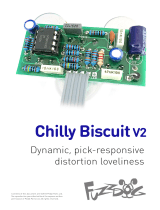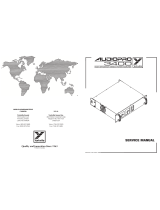Page is loading ...

Recurring Nightmare
Mad modulated fuzz delay
Contents of this document are ©2020 Pedal Parts Ltd.
No reproduction permitted without the express written
permission of Pedal Parts Ltd. All rights reserved.

Important notes
If you’re using any of our footswitch daughterboards,
DOWNLOAD THE DAUGHTERBOARD DOCUMENT
•Download and read the appropriate build document for the daughterboard
as well as this one BEFORE you start.
•DO NOT solder the supplied Current Limiting Resistor (CLR) to the main
circuit board even if there is a place for it. This should be soldered to the
footswitch daughterboard.
POWER SUPPLY
Unless otherwise stated in this document this circuit is designed to be
powered with 9V DC.
COMPONENT SPECS
Unless otherwise stated in this document:
•Resistors should be 0.25W. You can use those with higher ratings but
check the physical size of them.
•Electrolytics caps should be at least 25V for 9V circuits, 35V for 18V
circuits. Again, check physical size if using higher ratings.
LAYOUT CONVENTIONS
Unless otherwise stated in this document, the following are used:
•Electrolytic capacitors:
Long leg (anode) to square pad.
•Diodes/LEDs:
Striped leg (cathode) to square pad. Short leg to square pad for LEDs.
•ICs:
Square pad indicates pin 1.

R1 10K
R2 10K
R3 10K
R4 15K
R5 10K
R6 1K
R7 10K
R8 3K3
R9 10K
R10 10K
R11 82K
R12 6K8
R13 6K8
R14 3K6
R15 13K
R16 13K
R17 220R
R18 2K7
R19 680R
R20 10K
R21 10K
R22 1K
R23 470K
R24 470K
R25 10K
R26 10K
R27 1M
R28 100R
R29 8K2
R30 10K
R31 390R
C1 100n
C2 100n
C3 82n
C4 47n
C5 2n2
C6 33n
C7 2n2
C8 10n
C9 1u elec
C10 100n
C11 10n
C12 10u elec
C13 1u elec
C14 1u elec
C15 1u elec
C16 1u elec
C17 10u elec
C18 10u elec
C19 1u elec
C20 680n
C21 470p
C22 100n
C23 1u elec
C24 220p
C25 1u elec
C26 10n
C27 100u elec
C28 100u elec
C29 100u elec
C30 100u elec
US4* 100u elec
IC1 XR2206P**
IC2 PT2399
IC3 7660S***
IC1 MC33172P‡
D1 14001
D2-3 14001
U1 78L05
BLEND 1OOKB
DEPTH 100KC
FBACK 100KC
FUZZ 1MA
SPEED 1MA
TIME 100KA
VOL 100KA
WET/DRY SPDT ON-ON
WFORM DPDT ON-ON
Schematic
+ BOM
*We missed the label for C31 - it’s labelled as US4.
**Beware fakes. They simply won’t work. See later.
***Ensure you get a charge pump with the ‘S’ suffix or
you’ll get a whining noise from the circuit.
‡These op-amps are very hard to source in through-
hole format, thought SMT versions are readily available.
We’ve tried a few different substitutions and LM358 gives
the best results.


The power and signal pads on the PCB conform
to the FuzzDog Direct Connection format, so
can be paired with the appropriate
daughterboard for quick and easy offboard
wiring. Check the separate daughterboard
document for details.
If you aren’t using sockets for the ICs (why not?)
be extra careful and take your time soldering
them. They’re very easily to fry with heat.
You should solder all other board-mounted
components before you solder the pots. Once
they’re in place you’ll have no access to much of
the board. Make sure your pots all line up nicely.
The best way to do that is to solder a single pin
of each pot in place then melt and adjust if
necessary before soldering in the other two
pins. Same for the toggle switch. If your pots
don’t have protective plastic jackets ensure
you leave a decent gap between the pot body
and the PCB otherwise you risk shorting out
the circuit.
Snap the small metal tag off the pots so they
can be mounted flush in the box.
9V or 18V supply?
The circuit works best at 18V, so we’ve included
an on-board charge pump so you can achieve
this with a 9V supply. If you’d rather use a
dedicated 18V supply you can leave out all the
charge pump parts (marked in green on the
BOM) and add a jumper as shown in red above.
U1 will still drop the voltage going to the PT2399
to the required 5V.
PCB layout ©2019 Pedal Parts Ltd.

Testing
You can test the Distortion and Boost sections
individually, as if they’re separate boards. Do the test
wiring as shown below for each section.
UNDER NO CIRCUMSTANCES will troubleshooting help
be offered if you have skipped this stage. No exceptions.
Solder some nice, long lengths of wire to the board connections for 9V, GND, IN and OUT. Connect
IN and OUT to the jacks as shown. Connect all the GNDs together (twist them up and add a small
amount of solder to tack it). Connect the battery + lead to the 9V wire, same method. Plug in. Go!
You’ll have to connect the wire from pad O2 to either O1 or O3, or you’ll get no signal from the
Distortion section.
There’s no need to connect power to the OV and OG pads - these are purely to supply power to an
LED if you’re adding the Octave footswitch.
If you have a circuit tester (we sell a few!) just use that as normal.
Your completed circuit board
including pots

Wiring shown above will disconnect the battery when you remove the jack plug
from the input, and also when a DC plug is inserted.
The Board GND connections don’t all have to directly attach to the board. You
can run a couple of wires from the DC connector, one to the board, another to
the IN jack, then daisy chain that over to the OUT jack.
It doesn’t matter how they all connect, as long as they do.
This circuit is standard, Negative GND. Your power supply should be Tip
Negative / Sleeve Positive. That’s the same as your standard pedals (Boss etc),
and you can safely daisy-chain your supply to this pedal.
L
E
D
BOARD
OUT
BOARD
9V
BOARD
GND
BOARD
GND
BOARD
GND
BOARD
INPUT
BATTERY
+
IN
OUT
L
E
D
BOARD
GND
BOARD
9V
+
Wire it up (if using a daughterboard please refer to the relevant document)

FuzzDog.co.uk
Drilling template
Hammond 1590BB
It’s a good idea to drill the pot and toggle switch holes
1mm bigger if you’re board-mounting them.
Recommended drill sizes:
Pots 7mm
Jacks 10mm
Footswitch 12mm
DC Socket 8/12mm
Toggle switches 6mm
30mm
30mm
20mm
/
















